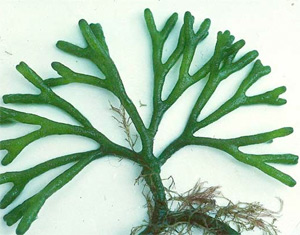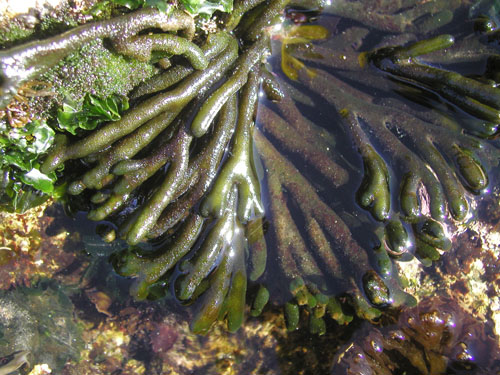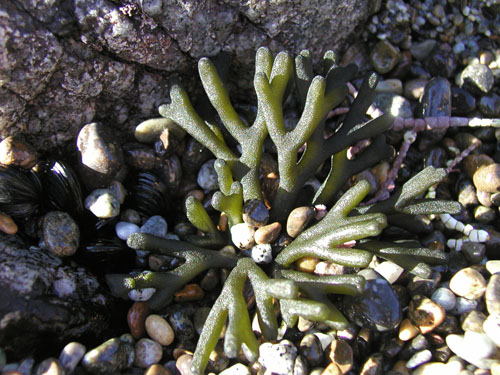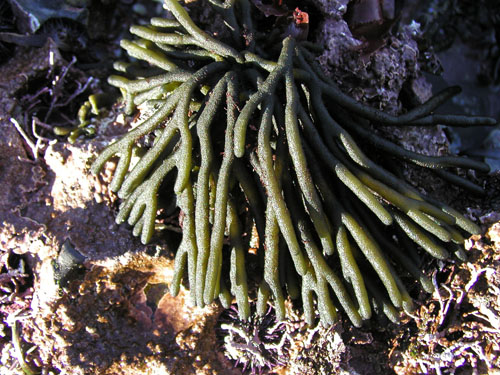
Dead Man's Fingers
Codium fragile
Overview
Key Features:
Dark green, cylindrical segments that are dichotomously branched.Primary Common Name:
Dead Man's FingersSynonymous name(s):
Acanthocodium fragileGeneral Grouping:
Green seaweed/algaeGeographic Range:
Sitka, Alaska to Bahia Asuncion, Baja California, Mexico
Codium fragile is native to the Pacific ocean from Sitka, Alaska to Bahia Asuncion, Baja California, Mexico and also in the Sea of Japan. In more recent years, a subspecies of Codium fragile has developed a more cosmopolitan distribution, including in the North Atlantic Ocean and the Mediterranean Sea as an introduced species.Intertidal Height:
-2 to 0.5 feet (-0.6096 to 0.1524 meters)Notes:
<em>Codium fragile</em> commonly occupies the mid to low intertidal.Subtidal Depth Range:
Minimum Depth: 0 meters or 0 feetMaximum Depth: 0 meters or 0 feet
Notes:
Codium fragile can be found in the subtidal, though less commonly than in the intertidal.Habitats:
bay (rocky shore), exposed rocky shore, kelp forest, protected rocky shoreNotes:
Codium fragile is typically a species of the outer coast and is found on rocky shores on the tops and sides of rocks in pools in the mid to low intertidal. It can also be found, though less commonly, in subtidal waters. Codium fragile also occupies large tide pools that are permanently filled with water.Abundance:
Relative Abundance:
Frequent to Common in mid to low intertidal, less common subtidally.Species Description:
General:
Codium fragile is a green alga in the family Codiaceae in the Phylum Chlorophyta. The genus is Greek for kodion, meaning small sheepskin. The two subspecies are Codium fragile tomentosoides, introduced into the North Atlantic in 1957, and Codium fragile fragile in the North Pacific. There are about 120 species in the genus Codium.Distinctive Features:
Codium fragile is a dark green alga with spongy texture. The holdfast resembles a small, broad cushion supporting erect branches that are 10 – 40 cm tall and look like dark green fingers, which serve as the inspiration for a few of its common names. These cylindrical segments are dichotomously branched, meaning they divide into two equal branches at each fork, and are 0.5 – 1.0 cm in diameter. The plant body is actually made of a number of interwoven, filamentous cells with incomplete crosswalls forming the inner part of the branches. This alga usually has a rather unpleasant, pungent odor. The surface layer of the branches is formed by elongate, club-shaped vesicles upon which the gametangia are produced. Often, the surface of the plant may be covered by small epiphytic algae, such as the filamentous red algae Ceramium sp..Codium setchellii can occur in the same water as Codium fragile, however it resembles a dark green sponge and forms a mat one cm thick and two to ten cm in diameter which has no upright branching part.
Size:
<em>Codium fragile</em> can grow to be 40 cm tall.Natural History:
General:
Codium fragile, like all green algae, is actually closer related to the green vascular land plants than they are to any other group of algae. They have the same photosynthetic system as vascular plants, which is dominated by the pigments chlorophyll a and b. These pigments give this group of algae their green coloration. Chlorophyll a and b also limit the depth at which green algae can grow since they absorb red light, which can only penetrate more shallow waters. Despite this, Codium fragile can in fact grow fast in low light levels, and thus is a superior competitor in the low itnertidal and subtidal areas. Growth of this species is, however, limited by short supplies of nitrogen during at least part of the year.Codium fragile is a siphonous alga, meaning that the entire organism is formed of interwoven and confluent filaments that are in fact a single multinucleate cell. These single long cells are called coenocytic and though they do have more than one nucleus, they have no cell walls separating them.
Codium fragile was introduced to New England in 1957 and has spread rapidly since then becoming a serious problem for the New England shellfish industry. The shells of mussels, scallops, and oysters provide a firm attachment surface for the small plants which then grow rapidly. Once the plants are large, surging waves crashing through shellfish beds tend to move the algae, and its host shellfish, away from their bed. Also, photosynthesis by Codium fragile can result in oxygen bubbles becoming trapped in its fronds and can cause the buoyant plant to float away carrying the mollusks with it.
Predator(s):
Codium fragile are eaten by some Opisthobranchs, such as Placida dendritica, a tiny and specialized ascoglossan sea slug.Prey:
Codium fragile nourishes itself through photosynthesis, converting the energy of light to the energy of carbohydrate molecules.Feeding Behavior:
PhotosyntheticReferences
O'Clair, R.M. 2000. North Pacific Seaweeds. Plant Press, Auke Bay, Alaska. 162 p.
- Abbott, I.A., and G.J. Hollenberg. 1976. Marine Algae of California. Stanford University Press, Stanford, California. 827 p.
- Langstroth, L. and L. Langstroth. 2000. A Living Bay: The Underwater World of Monterey Bay. University of California Press, Berkeley and Los Angeles, CA. 287 p.
- Mondragon, J. 2003. Seaweeds of the Pacific Coast: common marine algae from Alaska to Baja California. Sea Challengers, Monterey, CA. 97 p.
- Ocean Link. 2006. Seaweeds. World Wide Web electronic publication. http://oceanlink.island.net/oinfo/seaweeds/, Accessed [08/07/06].
- Rais, A. 2005. Marine Botany, Cystoseira osmundacea. http://www.mbari.org/staff/conn/botany/browns/Cystoseira/index.htm, Accessed [09/25/06].
Related Information
Photo Library
Click on an image below to view a larger version in the SIMoN Photo Library. You will also be able to view important information on each photo such as photographer, date, caption and more


